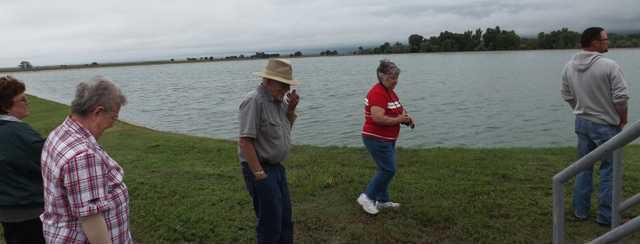HOISINGTON — The Hoisington City Council recently learned that upgrades are needed to the municipal sewage lagoon to bring it back into compliance with Environmental Protection Agency requirements.
At a special budget meeting on Monday, the council took time out to tour the lagoons. There are three ponds were built in the early 1980s.
The ponds were plumbed incorrectly when they were built and will require correction.
Ponds One and Two are about 12 acres with a depth of five feet and can hold 18,725, 317 gallons. The third lagoon is about 15 acres and can hold 27,223,360 gallons.
The combined surface area is 38.74 acres five feet deep and can hold a total of 64,673,994 gallons.
The lagoons were designed for a population of 5,314. The community is not that large at this time.
The most serious problem cited by the EPA was short-circuiting of the flow of effluent through the lagoons resulting in fecal bacteria amounts over the limits in discharges.
Public Works Director Paul Zecha said that the original contractor on the lagoons has gone bankrupt. The preliminary engineering plans show correct plumbing for the lagoons, but apparently the finalized plans were altered, also by an engineering firm.
The plumbing should discharge in the corners of the pools so that the effluent has the longest amount of time to travel through the pool. Instead, the water is being discharged in center of the lagoon.
Zecha said that on a normal day, the city discharges 180,000 to 190,000 gallons. With the recent rains, that amount had gone up to 469,000 gallons. The ponds were built for an average flow of 531,000, so the city is still within the capacity of the pond.
Also, with the recent drought, the level of fluids in the ponds were well within the limits of the pools.
The lagoons were designed for a retention time of 120 days, but the current retention time is 60 days.
An additional issue needing addressed is that the sludge has never been removed from the lagoons, which has also resulted in decreased capacity.
The lagoons are working inefficiently, City Manager Jonathan Mitchell told the council. The design was for 5,314 people, and the city’s populations is less than that.
Mitchell said, “It’s a serious issue we need to address. This is not an emergency situation, and we can correct these and have less impact on the environment.”
The city will raise sewer rates to $26.25 for 5,000 gallon, a 34 percent increase. The current rate for established residential customers is $19.60. The increase in sewer rates is needed to bring the city to the state average so that the city can apply for Community Development Block Grants to pay for the improvements.
The council voted to implement the increase in November. These rates will show up on the January bill.
Upgrades required on Hoisington sewage lagoons





